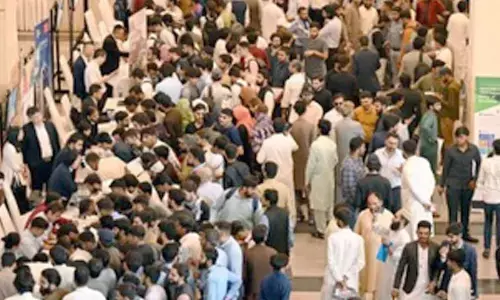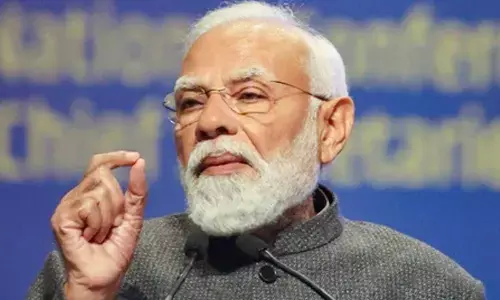Miles to go after first hurdle cleared

Miles To Go After First Hurdle Cleared, Lokpal Bill, New Anti-Corruption Law, Nilotpal Basu. At long last, the Lokpal Bill has been enacted by Parliament. The long arduous journey has cleared the first hurdle.
 At long last, the Lokpal Bill has been enacted by Parliament. The long arduous journey has cleared the first hurdle. Not that the new legislation is without flaws; but no law, for that matter, is perfect. Because ultimately quality of law is a function of contemporary political processes and manifestation of the balance of forces towards realising the objective of the proposed legislation. Doubtlessly, the process and the balance are conditioned by popular perception and intervention.
At long last, the Lokpal Bill has been enacted by Parliament. The long arduous journey has cleared the first hurdle. Not that the new legislation is without flaws; but no law, for that matter, is perfect. Because ultimately quality of law is a function of contemporary political processes and manifestation of the balance of forces towards realising the objective of the proposed legislation. Doubtlessly, the process and the balance are conditioned by popular perception and intervention.In the wake of the passage of the new anti-corruption law, commentators have widely attributed the enactment to the rise of the civil society movement against corruption led by Anna Hazare and more importantly to the recent stunning electoral debut of the Aam Aadmi Party in the Delhi polls. The contribution of Anna Hazare’s movement and its offshoot, AAP cannot be disputed. But having conceded this, a quick glimpse into the genesis of the Lokpal enactment would establish bonafides of a protracted battle with multiple contributions.
Therefore, to set the record straight, it is important to trace this journey. The notion of an institution akin to an Ombudsman was discussed both inside and outside Parliament throughout 1950s. It was only natural that with the new dawn in the Republic, the impulse to make governance more transparent and accountable would be that much more palpable. In those heady days, the Nehruvian rhetoric “hoarders and black marketers” will be “hung from the lampposts and publicly flogged” rent the air reflecting the public mood.
However, despite the rhetoric, Lokpal was first suggested as a constitutional authority by the Administrative Reforms Commission headed by Morarji Desai in 1966. This was when the mood was decidedly changing against the Congress with growing disillusionment over, among other things, lack of probity in public life. Since then, eight draft legislations came before Parliament but final enactment never saw the light of the day due to contentious issues and perhaps, the insufficient galvanisation of the public mood which could force respective governments in those relevant periods to enshrine this ant-corruption Lokpal institution in the statute books.
But the Left in India has consistently advocated its compelling necessity. The first major effort was in the backdrop of the Bofors scandal which rocked the collective conscience of the people and led to the formation of the VP Singh government. The government supported by the Left pushed for the legislation.
The second major push came in the 1996-97 period when the UF government was in office. It was during this period, that the major disputed issue as to whether the office of the Prime Minister would be included within the purview of the Lokpal was sorted out.
And, again in 2004, the issue of adopting a strong Lokpal legislation was included in the Common Minimum Programme (CMP). It was the draft born out of the commitment in CMP which has evolved into the current legislation.
What is noteworthy is that on all such instances, it was the Left which had been supporting the respective governments of the day. Therefore, attributing the passage of the enactment exclusively to the recent civil society movement would not be an accurate and balanced description of the outcome.
The disproportionate attribution to civil society and Anna Hazare, spearheaded by BJP and widely orchestrated by corporate media is understandable. On the other hand, the laboured efforts of Congress spokespersons to single out Rahul Gandhi, the young scion of the Gandhi-Nehru clan, as the principal protagonist offer a comic relief.
But such efforts are not unintentional; they are geared to obfuscate the very nature of corruption in high places that we are currently witnessing. With the onset of economic reforms in the beginning of 1990’s, it was claimed that corruption was a product of the license-quota raj, with political leaders and government officials wielding tremendous power in doling out public largesse. They implied that market with associated competitive environment will deliver a death blow on corruption.
Alas, that was not to be! Because what the reform process constituted was not disappearance of government; but an essential refashioning in its role and function. Contrary to its accountability to the citizens, its thrust was on ensuring the uninhibited play of the market. The natural consequence was ‘crony capitalism’.
Therefore, the current genre of corruption is largely policy-driven; flowing from policy change for ensuring handing over natural resource to private corporates. Natural resource, from spectrum to mines, land to forest, is a community asset for which the government had to act as trustee. This reauthoring of policy is leading to a powerful nexus between politicians, bureaucrats and corporates. This nexus is acting as fountainhead of current spate of corruption.
It is this context which propelled the demand for Lokpal. The final version of the law underlines that it has undergone major change from the original proposal in the face of opposition both inside and outside Parliament. After incorporation of amendments proposed by Select Committee, a principal concern has been largely addressed; that of rescuing the ‘caged parrot’ - CBI - from governmental control to supervision by Lokpal. However, no law can, by itself, provide a solution for the concerns for which the law is intended.
But what is really disturbing that the legislature has refused to take cognizance of the current policy driven nature of corruption; otherwise why would the final enactment refuse to bring the role of private corporates under purview of Lokpal, while being empowered for politicians and bureaucrats. With large number of government projects outsourced to them under PPP, this was only natural. However, notwithstanding these limitations, a beginning has been made; and positive at that. But what is heartening that it is already recognised that Lokpal cannot be a one-stop solution for our battle against corruption.
There is need to ensure thoroughgoing electoral reforms to offset money and muscle power; cleansing the judiciary through a national Judicial Commission legislation. There is a need to update and widen the definition of corruption in Prevention of corruption Act to include private corporates for which the government has proposed an amendment. Amendment of Article 105 of the Constitution to bring MPs under further anti-corruption scrutiny is another urgent requirement. But overall, passing laws is not the panacea for all ills. Policy is another vital area of public intervention, especially in the present context.
We have to go miles before we can sleep; because as somebody famously observed ‘eternal vigilance’ is the ‘price of liberty’-‘liberty from corruption’.
Next Story














